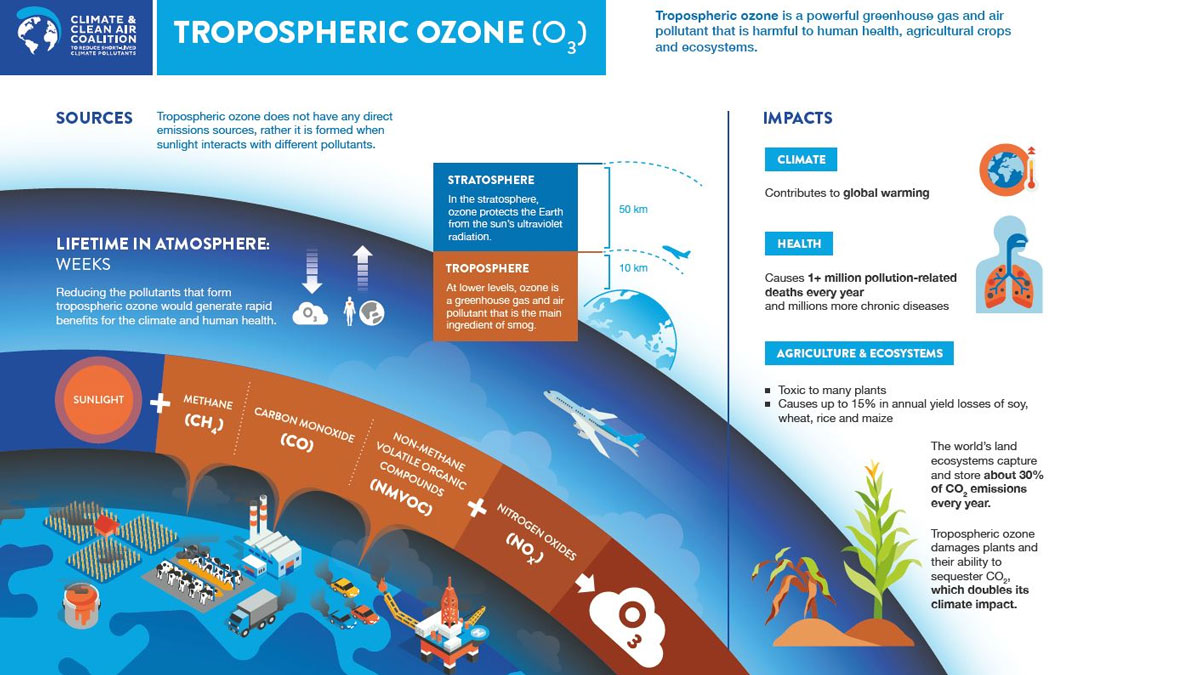Impact of Methane Emissions on Global Warming and Human Health
The threat that methane poses to global efforts to prevent dangerous climate change is becoming more well known. Methane emissions are increasing and because methane is many times more powerful than carbon dioxide at warming the atmosphere, these emissions are supercharging global warming. However, an impact of methane emissions that tends to receive less attention, is that it is a key ingredient in the formation of another greenhouse gas, ozone, in the lower atmosphere. Ozone is a prime element of smog and is toxic to humans and plants.
Methane’s links to respiratory diseases strengthens the case for its rapid reduction
Methane is the main precursor to ground-level ozone, a substance that has harmful health consequences that could increase as the world develops and global temperatures rise
- Reducing methane emissions could avoid nearly 0.3 degrees Celsius of global warming by 2040
- Reducing methane emissions by 40% by 2030 could prevent an estimated 180,000 deaths, 540,000 emergency room visits from asthma, and 11,000 hospitalizations of elderly people each year.
- Ground-level ozone can also physically damage plants and negatively impact crops, which means that methane reductions could prevent 18 million tons of crop losses by 2030, valued at USD 5 billion, every year.
“The air quality community has not talked about methane enough and the climate change community has not talked about the air quality issues of methane enough, the synergies between strategies is really something to work on very hard— and that’s why the Climate and Clean Air Coalition is important,” said Nino Künzli, a member of the CCAC’s Scientific Advisory Panel and Unit Head at the Swiss Tropical and Public Health Institute. “The vast majority of strategies to reduce air pollution are at the same time also reducing climate-relevant gases.”
Ozone is a complicated substance, created when chemical pollution reacts with sunlight. It is cyclical, which means that it increases in the afternoon and evenings during warm, sunny parts of the year.
Breathing ozone damages human lung tissues. The Global Burden of Disease estimates ozone was responsible for 11% of deaths from chronic respiratory disease (COPD) in 2019. Studies have estimated that ozone is responsible for about a million premature deaths per year. The range of its potential health impacts are varied, including breathing problems, reduced lung function, asthma, and chronic lung diseases.
In addition to having such significant health impacts, methane is also relatively short-lived with an atmospheric lifespan of about 12 years, so the health and climate effects of removing it will be felt very quickly. In fact, methane reductions will avoid nearly 0.3 degrees Celsius by 2040.
“You get a little bit of a quick win for climate through reducing methane and that’s quite important because what we need to be doing now is buying time while we move towards more structural changes to create a net zero carbon economy because it’s going to take time to get there,” said member of the Climate and Clean Air Coalition Scientific Advisory Panel Michael Brauer.
These quick wins could be dramatic for human health too. Reductions in ozone have the potential to prevent an estimated 180,000 deaths, 540,000 emergency room visits from asthma, and 11,000 hospitalizations of elderly people each year.
Ozone and the Future of Human Health
Michael Brauer and other experts are concerned ozone and its effects will only get worse without action. Since ozone is formed most readily from the reaction of precursor gases in the presence of sunlight and warm stagnant air, warming global temperatures are expected to increase its production. Human activity is also causing methane emissions to rise precipitously. At the same time, particulate matter levels appear to be stabilizing while ozone levels are increasing, which means that when it comes to the health impacts of air pollution, ozone could be a much greater concern in coming years.
The death toll of ozone also doesn’t fully encompass its potential damage. The number of people who do not die but suffer decreased quality of life or drive-up national healthcare spending is likely much, much higher. Given that it damages lungs, people with asthma and COPD (chronic obstructive pulmonary disease) may suffer decreased lung capacity and increased disease severity. This is particularly a concern for the hundreds of thousands of COPD and asthma sufferers living in developing countries where they are less likely to have access to the life-saving medicine used to manage the chronic health condition. For these groups, a future with continually increasing ozone levels could have life or death implications.
Another concern about ozone is that it is likely decreasing labour productivity in agricultural and other outdoor workers exposed to ozone and suffering from its negative health impacts. One paper found that even exposure to ozone levels significantly lower than American federal air quality standards had an impact on productivity, furthering an economic as well as a health argument for action.
That isn’t ozone’s only impact on the agricultural sector, however. Just as it is damaging for humans to breathe, it is dangerous for plants to absorb because it can physically damage plant matter.
Vital global crops, including cotton, peanuts, soybean, winter wheat, and corn have all been shown to be negatively impacted by ozone. The effects can be dramatic: Crop losses due to ozone total an estimated 79–121 million tonnes, worth USD 11–18 billion annually. Achieving methane reductions could prevent 18 million tons of crop losses, valued at USD 5 billion per year.
At a time when the World Food Programme is warning that the COVID-19 pandemic could double the number of severely hungry people in the world, increasing crop production while tackling climate change is more essential than ever.
Taking action
These damaging health impacts only add to the growing impetus for reducing methane emissions worldwide.
“The evidence of the health effects of air pollution has never been as strong and high and clear, the scientific progress in the last 20-30 years was enormous and it went continuously in the same direction, which is that we have more and more causal evidence,” pointed out Nino Künzli.
Michael Brauer added that because methane emissions are highly concentrated in the agriculture sector (predominantly from cattle) and the fossil fuel sector (mostly from oil and gas), it makes it a lot easier for policymakers to target action and write more effective policies because they can focus on a few industries and sources.
The CCAC has a variety of initiatives working to reduce methane emissions. The Global Methane Alliance convenes governments, financing institutions, and NGOs to support ambitious reductions from the oil and gas industry. The Oil and Gas Methane Partnership is a voluntary initiative that helps companies reduce their methane emissions. In the agricultural sector, the CCAC is working around the world to help countries reduce methane emissions through relatively simple and affordable projects including livestock and manure management, paddy rice production, and enhancing their agriculture Nationally Determined Contributions.
The World Health Organization is also working on developing new and significantly more rigorous air quality guidelines, which Brauer and Künzli are helping to develop and are expected to be released this summer.
“Never before have air quality guidelines been so methodologically rigorous and systematically done,” mentioned Künzli. “The major challenge that the World Health Organization already has, even before publishing their updated quality guidelines, is the compliance piece between what WHO is proposing and what governments around the world are adopting in their legal regulations.”
Künzli hopes that the growing evidence not only of the damaging health effects of air pollutants like particulate matter and ozone but that their role in driving climate change will be further impetus governments need to step up their air quality regulations.
Action on methane, and therefore ozone, exemplifies a growing lesson in the climate and clean air communities: that marrying action on both is the most effective path forward for both planetary and human health.
Source: Climate and Clean Air Coalition







